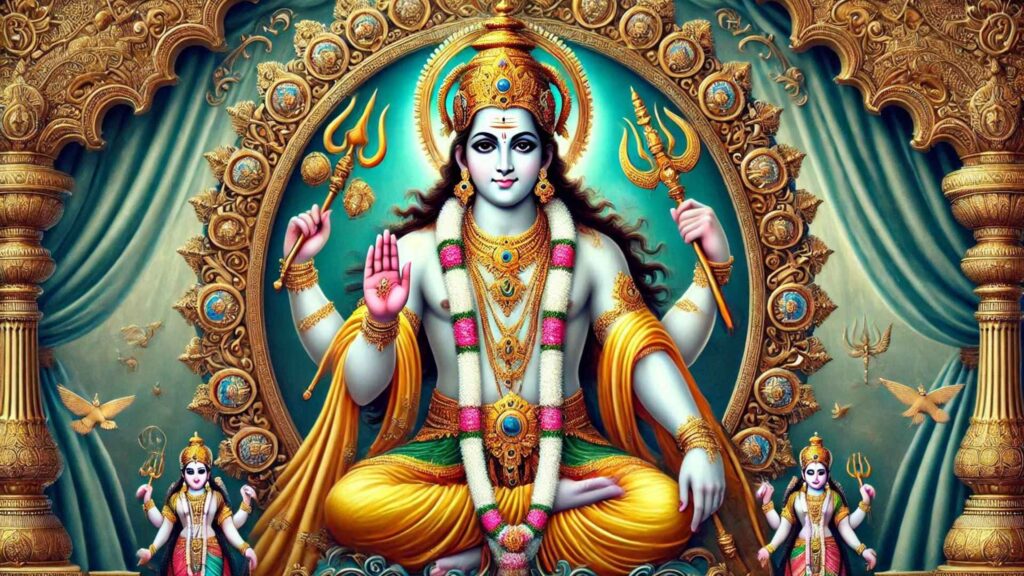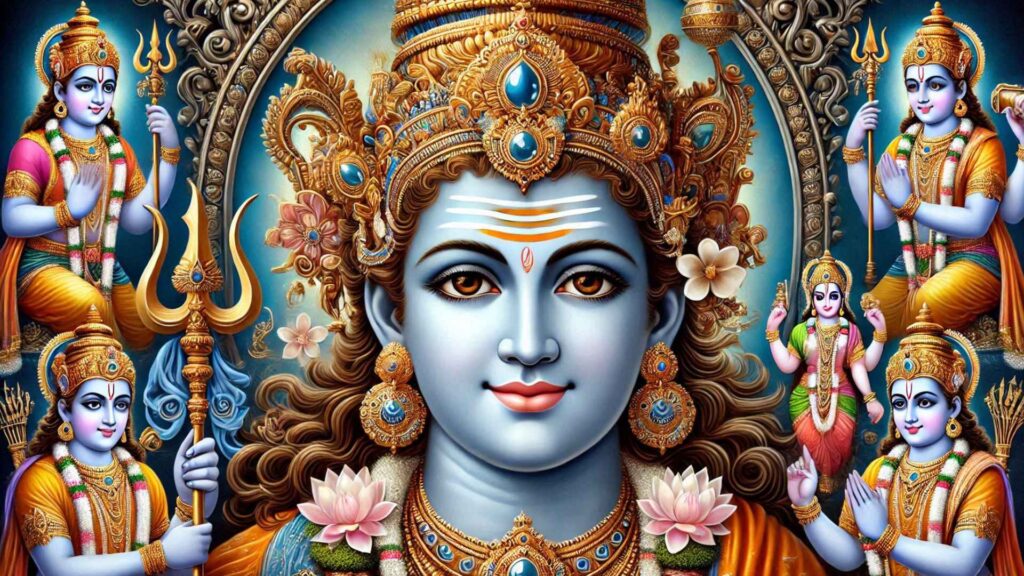Lord Hari: The Preserver and Embodiment of Divine Love
Introduction
Lord Hari, a revered name for Lord Vishnu, symbolizes the supreme preserver and protector of the universe in Hinduism. Known for his compassion, mercy, and role in maintaining cosmic balance, Hari is worshipped as the embodiment of divine love and harmony. He is one of the principal deities in the Hindu trinity (Trimurti), alongside Brahma (the creator) and Shiva (the destroyer).
Read More About Deities And Gods
Hari’s presence in daily Hindu life extends beyond rituals, inspiring values of kindness, justice, and devotion. Through his avatars, including Rama and Krishna, he has guided humanity, showcasing the principles of dharma (righteousness) and bhakti (devotion).
Significance of Lord Hari in Hinduism
In Daily Hindu Life
Hari represents the nurturing and preserving aspect of the divine, ensuring the sustenance of life and protection against evil. His name is invoked in prayers, mantras, and daily rituals, symbolizing peace, stability, and divine blessings.
Cosmic and Spiritual Importance
As the preserver, Hari maintains the equilibrium of the cosmos, intervening whenever dharma is threatened. His cosmic role reflects the interconnectedness of all beings and the divine order that sustains the universe. Spiritually, he guides devotees toward liberation (moksha) through devotion and selfless actions.
Names and Etymology

Meaning of Hari
The name “Hari” originates from Sanskrit and means “one who removes” or “the destroyer of sins, sorrows, and ignorance.” It also translates to “one who takes away,” symbolizing his ability to dissolve negativity and grant liberation.
Other Names of Hari and Their Significance
- Vishnu: The all-pervading one, signifying his omnipresence.
- Narayana: The refuge of all beings, denoting his protective nature.
- Govinda: Protector of cows and the earth, symbolizing his role as a nurturer.
- Madhava: The consort of Goddess Lakshmi, representing prosperity and love.
- Keshava: The slayer of the demon Keshi, symbolizing his role as a protector.
Each name encapsulates a unique facet of Hari’s divine persona and his cosmic responsibilities.
Symbolism and Iconography

Physical Description of Hari
Lord Hari is often depicted as a serene figure with four arms holding a conch (shankha), discus (chakra), mace (gada), and lotus (padma). He is adorned with a yellow robe and resides on the celestial serpent, Adishesha.
Symbolism
- Conch (Shankha): Represents sound, the cosmic vibration that sustains the universe.
- Discus (Chakra): Symbolizes the cyclical nature of time and divine justice.
- Mace (Gada): Denotes strength and protection.
- Lotus (Padma): Reflects purity, detachment, and spiritual enlightenment.
Flower Connection
The lotus is closely associated with Hari, symbolizing purity and divine wisdom amidst worldly chaos.
Colors and Symbols
- Yellow: Represents knowledge, prosperity, and divinity.
- Blue: Denotes his infinite and all-encompassing nature.
Mythology and Stories

Birth Story
Hari, as a manifestation of Vishnu, is considered eternal and uncreated. However, his appearances as avatars (incarnations) like Rama and Krishna are central to Hindu mythology, where he descends to restore dharma and protect devotees.
Connection with Other Gods
- Brahma: Hari collaborates with Brahma in the creation and sustenance of the universe.
- Shiva: His relationship with Shiva reflects the cyclical process of preservation and destruction.
- Lakshmi: As his consort, Lakshmi complements Hari’s nurturing and preserving qualities.
Role in the Ramayana and Mahabharata
- Ramayana: Hari incarnates as Lord Rama, upholding dharma and defeating Ravana.
- Mahabharata: As Krishna, he serves as a guide and philosopher, delivering the Bhagavad Gita’s teachings.
Famous Blessings and Boons
Hari is known to grant moksha, prosperity, and protection to his devotees. His blessings include liberation from the cycle of birth and death, inner peace, and divine guidance.
Spiritual Significance
A Visible Form of God
Hari’s avatars, such as Rama and Krishna, are accessible forms of the divine, making his teachings and presence relatable for devotees.
Representation of Knowledge and Enlightenment
Hari symbolizes wisdom, enlightenment, and the path to self-realization, offering guidance through the principles of dharma and bhakti.
Connection to Spiritual Awakening
Through devotion to Hari, devotees achieve inner harmony, freedom from ego, and a deeper connection with the divine.
Role in Yoga and Meditation
Hari’s imagery and mantras are integral to meditation practices, helping individuals achieve focus, peace, and spiritual awakening.
The Mantra Connection
One of the most powerful mantras dedicated to Hari is:
“Om Namo Narayanaya”
This mantra invokes his presence, fostering spiritual growth and divine protection.
The Vishnu Sahasranama (a thousand names of Vishnu) is also recited to honor Hari and seek his blessings.
Worship and Rituals
Benefits of Worship
- Attainment of peace, prosperity, and happiness.
- Removal of obstacles and negativity.
- Guidance toward spiritual growth and liberation.
Daily Worship Practices
- Offering flowers, fruits, and Tulsi leaves to his idol.
- Lighting lamps and chanting his mantras.
- Reading scriptures like the Vishnu Purana and Bhagavad Gita.
Significance of Day
Hari is especially worshipped on Thursdays and during festivals like Ekadashi and Vaikunta Ekadashi.
Important Festivals
- Vaikunta Ekadashi: Celebrates the opening of Vishnu’s celestial abode.
- Janmashtami: Marks the birth of Krishna, an avatar of Hari.
- Rama Navami: Celebrates the birth of Rama, another avatar of Hari.
Famous Temples
- Tirupati Balaji Temple, Andhra Pradesh.
- Ranganathaswamy Temple, Tamil Nadu.
- Jagannath Temple, Odisha.
- Badrinath Temple, Uttarakhand.
Modern Relevance
Scientific Understanding
Hari’s principles of harmony and preservation align with modern concepts of sustainability and balance in nature.
Environmental Consciousness
Hari’s association with the preservation of life encourages eco-friendly practices and respect for all living beings.
Health Benefits
Chanting Hari’s mantras is believed to reduce stress, enhance concentration, and promote emotional well-being.
Cultural Impact
Influence on Indian Art and Architecture
Hari’s imagery is a prominent motif in temple carvings, murals, and sculptures, reflecting his central role in Hindu worship.
Presence in Literature and Poetry
Hari’s tales and teachings are celebrated in epics like the Ramayana, Mahabharata, and various devotional songs and poems.
Impact on Daily Customs
Hari’s name and teachings are integral to Hindu prayers, rituals, and ethical practices.
Regional Variations in Worship
- South India: Elaborate rituals in Vishnu temples.
- North India: Emphasis on Krishna and Rama as his avatars.
Practical Applications
Morning Prayers and Rituals
Chanting Hari’s mantras at dawn fosters positivity, focus, and a deeper connection with the divine.
Dietary Recommendations
Observing a sattvic (pure) diet during worship aligns with his principles of purity and balance.
Astrological Significance
Hari’s worship is believed to mitigate planetary afflictions and ensure peace and prosperity.
Gemstones and Metals
Yellow sapphire and gold are associated with Hari’s energy and auspiciousness.
Conclusion
Lord Hari is the eternal preserver, guiding humanity through his teachings, avatars, and divine grace. His presence inspires devotion, courage, and the pursuit of righteousness, offering a path to inner peace and spiritual liberation.


